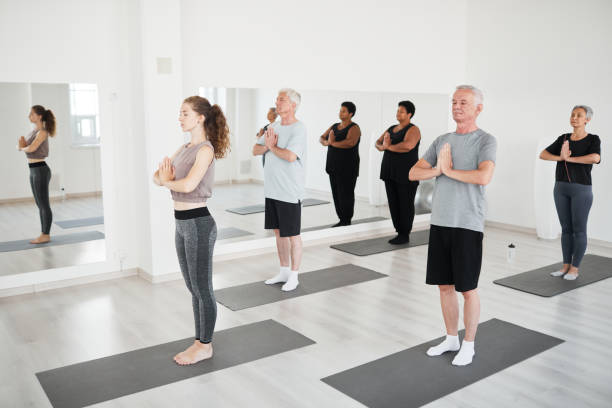Introduction

Exercise is widely recognized as an important part of good health, but its impact on metabolic syndrome in Parkinson's patients has been largely overlooked. Metabolic syndrome, or MetS, is a group of risk factors such as obesity, high blood pressure, and elevated levels of cholesterol or triglycerides.
Recent research suggests that physical activity can help reduce the risk of developing MetS in Parkinson's patients. In this blog post, we'll explore the potential benefits of exercise for those living with Parkinson's and how it may be linked to metabolic syndrome. We'll also discuss some tips for incorporating activity into your daily routine.
What is a metabolic syndrome in Parkinson's?
Metabolic syndrome refers to a cluster of risk factors that can increase the chances of developing health problems such as cardiovascular disease issues. It has been linked to Parkinson's disease, which can cause symptoms like difficulty with movement, cognitive problems, fatigue, and weight gain.
People with Parkinson's are at higher risk for metabolic syndrome due to their lifestyles, such as lack of physical activity, poor diet, and inadequate medication. These factors can contribute to weight gain, increased cholesterol levels, and insulin resistance.
The Link between Exercise and Met Syndrome in Parkinson's Patients
Exercise is one of the most important components for managing metabolic syndrome in people with Parkinson's. It can help reduce body fat, lower cholesterol levels, and improve insulin sensitivity. Exercise also improves overall physical strength and endurance, helping to offset fatigue and muscle weakness associated with Parkinson's disease.
Regular aerobic exercise is recommended for people with Parkinson's as it is beneficial in reducing symptoms of metabolic syndrome. Aerobic exercise includes walking, jogging, running, cycling, and swimming. Starting at a moderate intensity is important, gradually increasing as fitness levels improve.
Strength training can benefit people with Parkinson's as it helps build muscle mass and strength. This can help maintain functional independence and reduce falls in people with the disease. Examples of strength training include resistance bands, free weights, and bodyweight exercises such as squats and push-ups.
Overall, exercise is important for managing metabolic syndrome in Parkinson's patients. Cardio and weightlifting workouts may help alleviate metabolic syndrome symptoms and enhance physical performance. For those with Parkinson's, exercise is a great way to stay healthy and active.
Exercise for People with Parkinson's

For individuals with Parkinson's disease, incorporating exercise is crucial for maintaining good health. It helps to maintain physical and mental well-being, mobility, flexibility, and strength. Exercise also can potentially reduce symptoms of depression common in Parkinson's patients.
Improved Cardiovascular Health
One area of focus regarding exercise for Parkinson's patients is improved cardiovascular health. Research indicates that regular physical activity can reduce the risk of developing metabolic syndrome, including high blood pressure and elevated cholesterol levels. A meta-analysis of several studies found that exercise positively impacted metabolic syndrome in these patients.
The Benefits of Resistance Training
To clarify, resistance training is a form of exercise that involves pushing or pulling against resistance or weight. This could be free weights, like dumbbells, or machines designed for resistance training. This type of exercise has many benefits for people with Parkinson's disease. It helps to improve strength and balance and reduce the risk of falls. Research has also revealed that resistance training can significantly improve these patients' physical abilities, such as walking and daily activities.
Getting Started with Exercise

Before beginning any exercise program, it is important to seek guidance from a doctor or healthcare professional. They can provide specific advice on the types of exercise suitable for each patient. It is also important to start slowly and gradually increase the intensity of physical activity over time.
By exercising regularly, people with Parkinson's can improve their cardiovascular health and reduce the pd risk of metabolic syndrome. Resistance training is particularly effective for improving strength, balance, and other physical abilities related to daily activities. With the guidance of a healthcare professional, people with Parkinson's can safely and successfully incorporate exercise into their daily routines for better overall health.
Challenges to Consider When Exercising with Parkinson's Disease
If you have Parkinson's disease, exercise can be a great way to help manage the symptoms. Exercise has been shown to improve balance, coordination, and mobility and reduce fatigue and depression.
However, people with Parkinson's also face challenges when exercising. For example, individuals with Parkinson's may have difficulty initiating movements and maintaining balance and coordination due to the progressive loss of muscle control. Basic can be difficult for many individuals with this condition due to the accompanying fatigue.
Therefore, those with Parkinson's need to exercise caution. It is recommended that individuals speak to a physiotherapist or other healthcare professional before beginning any form of exercise program. This way, they can get advice on what exercise best suits them and helpful tips and techniques for staying safe while exercising.
To manage the symptoms of Parkinson's, it is important to engage in regular physical activity. With careful consideration, individuals with this condition can still lead active lives and benefit from the positive effects that exercise can bring. They must balance exercising enough to stay healthy while not overdoing it and risking injury or exhaustion. Exercise is one way to help manage many physical changes associated with Parkinson's disease.
Why does exercise slow down Parkinson's?
Exercise has been shown to help relieve some of the motor symptoms of Parkinson's, such as body stiffness, imbalance, and tremors. Research suggests that exercise is one of the most effective strategies for managing Parkinson's. Regular physical activity can reduce the progression of the disease by improving muscle strength, balance, and coordination.
Additionally, exercising helps with fatigue, sleep problems, and depression, common non-motor symptoms of the disease. Exercise also helps to reduce inflammation, which has been linked to Parkinson's progression. Additionally, exercising can help with cognitive functions such as processing speed and memory, which become impaired as the disease progresses.
Exercise may slow down the progress of Parkinson's by reducing dopamine-degrading enzymes in the brain and increasing dopamine levels. Exercise also helps to increase blood flow, which can help protect nerve cells and optimize function. Additionally, a combination of aerobic exercise, strength training, balance activities, and stretching has improved the quality of life for people with Parkinson's.
What are the major barriers to exercise for people with Parkinson's disease?
It can be challenging for individuals with Parkinson's to participate in physical activity due to various disabling physical and cognitive symptoms they may experience.
Some of the major barriers to exercise for people with Parkinson's include:
Difficulty initiating and maintaining movement - People with Parkinson's often struggle with motor control, which can lead to difficulty initiating and maintaining movement. This can make it difficult for them to start and follow through with physical activity.
Balance problems - People with Parkinson's often experience problems, making walking, jogging, or cycling harder.
People with Parkinson's often experience fatigue, hindering their ability to participate in regular physical activities.
Cognitive difficulties - People with Parkinson's may experience cognitive impairments, like difficulty concentrating or memory problems, which can lead to difficulty following through on an exercise plan.
Despite these barriers, it is still possible for people with Parkinson's to engage in physical activity safely. Regular exercise is beneficial for people with Parkinson's disease, helping to improve strength, balance, and overall quality of life. To maximize the benefits of physical activity, it is important to work closely with a physician or physical therapist who can ensure that the activity plan is tailored to the individual's physical and cognitive needs.
What are some tips for staying active with Parkinson's disease?
1. Stay connected with your healthcare team. Ensure you have regular check-ups and keep an open dialogue about symptoms and treatment strategies with your doctor.
2. Establish a regular physical activity routine tailored to your needs and lifestyle, such as walking, biking, swimming, yoga, or Tai Chi.
3. Seek out Parkinson's-specific exercise groups or classes, which can provide education and support from people with similar experiences.
4. Participate in activities that bring pleasure and joy to your day, such as gardening, dancing, painting, or playing card games.
5. Find a companion for physical activity, whether a friend, family member, or personal trainer. Staying active will be easier with this, as it will assist in keeping you motivated and accountable.
6. Invest in adaptive equipment, such as walkers or specialized bikes, to make certain activities easier and more comfortable.
7. Incorporate strength training into your routine with the help of resistance bands, dumbbells, or a weight machine.
8. Maximize your functional mobility with stretching and balance exercises that can be done in the comfort of your home.
9. Utilize technology through virtual classes and telehealth services to access physical activity sessions with certified professionals.
10. Track and record your progress to stay motivated and celebrate successes!
FAQ's
How does exercise affect metabolic function?
Regular exercise has been shown to improve metabolic function, which can help lower the risk of developing chronic kidney disease health conditions such as heart disease, diabetes, and obesity. Exercise increases the body's production of hormones such as insulin and glucagon, allowing for improved glucose metabolism and nutrient uptake in cells.
Why does exercise affect the metabolic rate?
Exercise increases metabolic rate through increased energy expenditure (calories burned), increased muscle mass, and improved hormonal regulation. Muscle mass plays an important role in metabolic rate because it uses more energy than fat tissue when active - meaning that the more muscle you have, the higher your metabolism is.
What causes Parkinson's syndrome?
The cause of Parkinson's syndrome is still unknown, but researchers believe it to be the result of a combination of genetic and environmental factors. It is believed that certain changes in genes increase the risk of developing Parkinson's, while other environmental factors — such as exposure to certain toxins or viruses — can also play a role.
What disease is related to Parkinson's disease?
The most common diseases related to Parkinson's are progressive supranuclear palsy (PSP), multiple system atrophy (MSA), and corticobasal degeneration (CBD). While these diseases share some of the same symptoms as Parkinson's, they each have distinct characteristics that differentiate them.
Can physical activity improve symptoms of Parkinson's disease?
Yes, there is evidence to suggest that physical activity can help improve mobility and reduce motor symptoms in people with Parkinson's disease. Regular exercise can also help improve balance, coordination, flexibility, strength, and mental health. Furthermore, it has been found that engaging in regular physical activity can lower the risk of experiencing complications associated with Parkinson's disease.
Conclusion
I hope this article has provided helpful information about how physical activity can benefit people with Parkinson's disease. Exercise is an important part of managing the symptoms of Parkinson's, and it is important to find a routine that works for you and fits into your lifestyle. With the right exercise program, you can improve your overall quality of life and progress toward reaching your goals.

